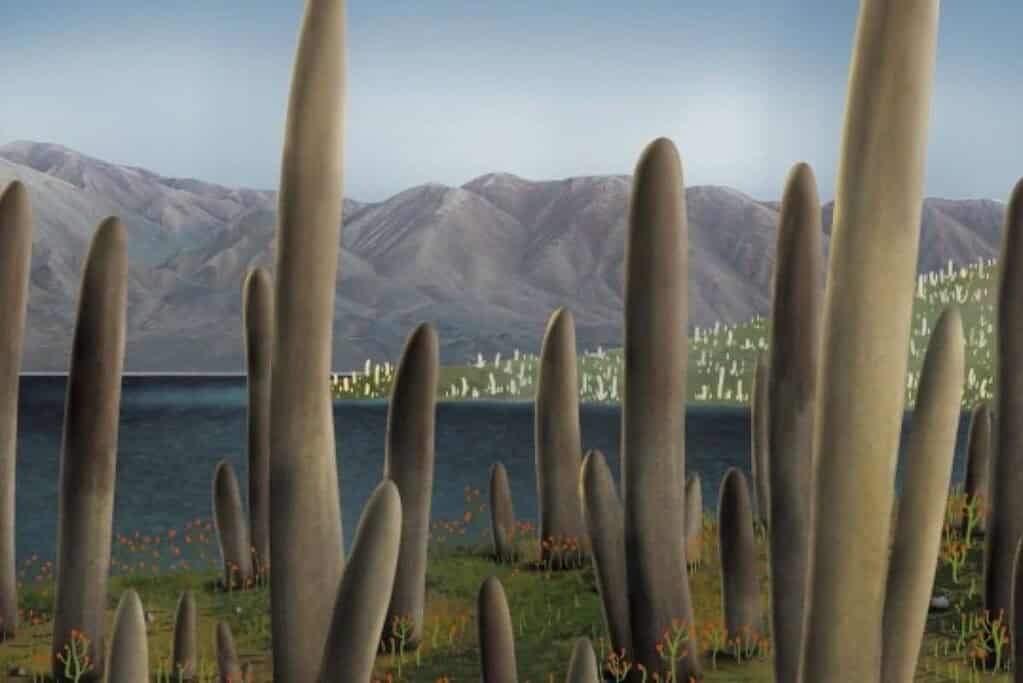
Millions of years before the first trees grew their canopies and the earliest insects buzzed, a strange organism sprouted from the ground. It looked like a trunk, cylindrical and bare, stretching over 20 feet into the Devonian sky. But it had no leaves. No branches. No clear kin. For nearly two centuries, paleontologists argued about what this bizarre life-form was.
Now, new research suggests Prototaxites — long thought to be a colossal fungus — may have belonged to a completely unknown chapter in the story of life on Earth. Not a plant, not an animal, and not a fungus — but something entirely different.
A Branch with No Tree
The fossil record first met Prototaxites in 1843, buried in ancient rocks that hinted at some enormous tree. Due to its vast size — up to 26 feet tall and 3 feet wide — it was first mistaken for the remains of rotting conifer trunks. But that suspicion crumbled once scientists realized conifers didn’t yet exist when Prototaxites flourished, between 420 and 375 million years ago. The first trees appeared around 350 million years ago.
In 2007, a team led by Stanford geobiologist Kevin Boyce found that carbon isotopes in the fossils resembled those of fungi — not plants. The chemical data suggested that Prototaxites absorbed carbon from other organisms rather than using photosynthesis. This is a hallmark of fungal life. So, at the time, it seemed the mystery had been solved.

However, a new study led by paleobiologist Corentin Loron at the University of Edinburgh has flipped the script once again. Using preserved fossils from a site in Aberdeenshire, Scotland — the famed Rhynie chert (a Lower Devonian sedimentary deposit) — Loron and his colleagues examined a smaller species known as Prototaxites taiti. Though only a few inches tall, its internal structures were intact enough to dissect in detail.
What they found was deeply peculiar.
Not Fungi Either
Under the microscope, P. taiti showed an elaborate network of tubes — a feature fungi are known for. But the resemblance stopped there. These tubes curved, branched, and looped in ways not seen in any modern fungi. Some were thick-walled and unbranched, others thin and highly branched. Some bore faint rings — growth patterns fungi don’t typically show.
Even more striking was its chemistry. The fossil left no trace of chitin, the tough sugar compound found in the cell walls of all fungi. Instead, its molecular signature resembled lignin — a polymer found in woody plants — though it was still chemically distinct from anything botanists have cataloged. This difference was made clearer by comparing Prototaxites with bona fide fossil fungi found in the same rock layer. The fungi bore unmistakable signs of chitin. Prototaxites did not.
“Having found no support for the most widely held view that Prototaxites was fungal, we next reviewed possible placement in other higher taxonomic groups. No extant group was found to exhibit all the defining features of Prototaxites,” the team wrote in their paper, for now posted on the preprint server bioRxiv.
The scientists conclude that Prototaxites likely belonged to “a previously undescribed, entirely extinct group of eukaryotes.”
In the grand tree of life, that’s a big claim. Eukaryotes — organisms with complex cells — include animals, plants, fungi, and protists. But this ancient tree-like giant, the researchers argue, fits in none of these categories. It stands apart.
Before Trees and Insects
The notion that Prototaxites was not a fungus but an unknown branch of life has stirred intrigue and, inevitably, some skepticism.
“The assumption that it was likely to be in the fungi was somewhat nebulous, particularly given the nature of the fossils, and seemed somewhat counterintuitive given the relatively massive size,” Brett Summerell, a fungus expert at the Botanic Gardens of Sydney, told New Scientist. “The conclusion that it is a completely unknown eukaryote certainly creates an air of mystery and intrigue around it — probably not likely to be solved until more fossils are discovered or new analytical techniques developed.”
A new kingdom of life unknown to science wouldn’t be out of question. Nature has experimented wildly throughout Earth’s history. Many ancient lineages have disappeared without leaving living descendants. The Ediacaran biota, for example, vanished 540 million years ago after a short, enigmatic reign — leaving no descendants behind.
Kevin Boyce believes the organism may have been “a novel experiment with complex multicellularity that is now extinct.” It may not have photosynthesized like a plant. It didn’t decompose like a mushroom. And it certainly didn’t walk, swim, or crawl. But it grew. It fed. It thrived for tens of millions of years. Then it vanished.
Why Prototaxites disappeared could be explained by a number of different things. Perhaps it was outcompeted by newly evolving land plants and fungi. As early shrubs and trees colonized Earth’s surface, the towering structures of Prototaxites may have lost their ecological niche.
These mysteries and more might be solved with new findings in the future.









